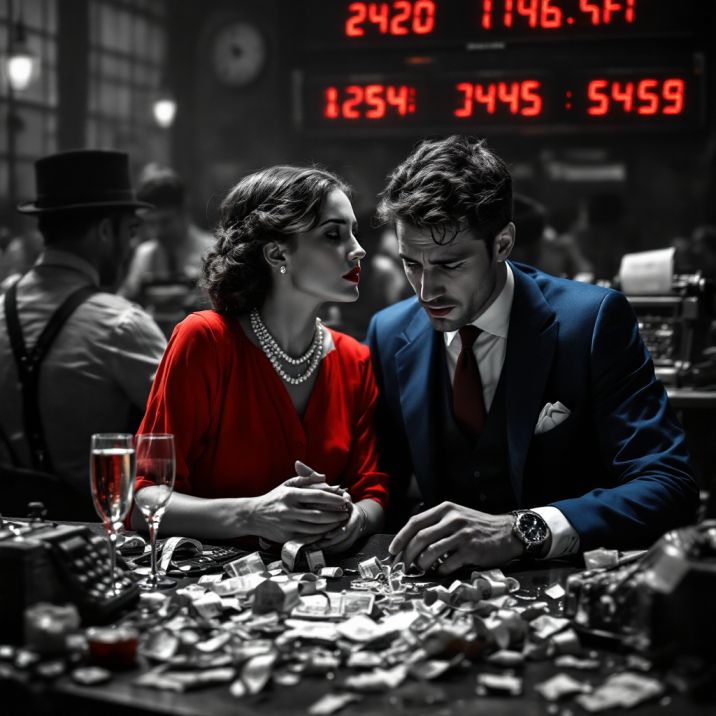US Stock Market Crash History: The Cunning Art of Capitalizing on Chaos
Nov 24, 2024
History has shown us that stock market crashes are as inevitable as brutal. But as Machiavelli would say, power is not merely seized—it’s earned through strategy, cunning, and, above all, understanding the human psyche. The US stock market has long been a battlefield where emotions, greed, and manipulation reign and where crashes are not just failures but opportunities for those shrewd enough to see them. The 2008 financial crisis, a cataclysm fueled by overvalued subprime mortgages, perfectly encapsulated this chaos. Yet, as John Bogle warned, the pursuit of quick profits lured many into reckless speculation, and those who sought to exploit others’ desperation reaped rewards for their schemes.
Consider the lessons of Machiavelli, who viewed conflict as a struggle for power, control, and influence—ideals that can be readily applied to the dynamics of market crashes. The 1980s insider trading scandal, where elites manipulated information for personal gain, mirrors his notion of “virtù”—strategic boldness in exploiting situations. As these crashes occur, it’s not mere misfortune; it’s the consequence of human arrogance, manipulation, and a lack of restraint.
The Dance of Arrogance and Ignorance: A Cunning Market Trap
Look at the 1929 stock market crash—Black Tuesday. It was a spectacle of arrogance, where unchecked optimism and speculative excess reached grotesque levels. Blinded by the myth of an unyielding market, investors made one fatal mistake: they ignored the cyclical nature of markets. It was arrogance that convinced them the boom would last forever. It was ignorance that left them unprepared for the inevitable collapse. This dual force creates volatility—where market players, intoxicated by the allure of wealth, refuse to see the inevitable reversal.
Today’s investors must heed this lesson: don’t fall prey to the myth that markets only rise. Even in times of prosperity, there is always the risk of collapse. This has been proven repeatedly—from the Dot-Com Bubble of the late ‘90s, which saw speculative mania surrounding the internet, to the housing bubble of 2008, where reckless lending and convoluted derivatives caused the market to implode. Those who could not separate illusion from reality were the first to fall.
Mass Psychology: The Collective Madness
What happens in a market crash is not just a financial event; it’s a psychological phenomenon. When the masses panic, they move in unison, driven by fear, greed, and herd mentality. This is where Machiavellian strategy comes into play: understanding that the true power lies in controlling the masses. During times of fear, prices fall, and irrationality reigns. But, as Warren Buffett so astutely advised, “Be fearful when others are greedy, and greedy when others are fearful.” It’s during these moments of collective madness that true fortunes are made. Investors who can stay calm, assess the underlying value of assets, and buy when others are selling irrationally position themselves to thrive in the aftermath.
Take the 2008 financial crisis—those who bought when others were selling saw their investments grow exponentially. The same occurred during the COVID-19 crash in 2020. Fear reached its peak, and the market bottomed out. But those who recognized the opportunity amidst the panic—the true strategists—were poised for a sharp recovery when the dust settled. Understanding mass psychology is not about following the crowd but knowing when to stand apart and take action.
Cognitive Biases: The Hidden Forces that Shape Our Fate
Investors are not rational. They are creatures of emotion, subject to cognitive biases that cloud judgment and lead to catastrophic decisions. Confirmation bias, for example, compels investors to seek information supporting their preconceived beliefs, disregarding warnings and contrary evidence. Overconfidence bias pushes them to believe they have an edge, even when the odds are stacked against them. Loss aversion—an intense fear of losing what one already has—leads to irrational decision-making, such as selling out in a panic rather than holding on to strong assets for the long haul.
These biases compound during market crashes, where fear and irrationality rule the day. The mass psychology of panic, fueled by cognitive distortions, ensures that even the most experienced investors can make disastrous decisions. But here lies the Machiavellian insight: intelligent investors use these biases to their advantage. The key is to recognize them not as weaknesses but as tools to predict the behaviour of others. The shrewd investor knows it’s time to buy when everyone is selling out of fear.
Technical Analysis: Reading the Market’s Pulse
Technical analysis is the modern equivalent of observing the battlefield’s terrain and reading the enemy’s movements. It’s the study of price patterns, volume, and historical data—tools that allow investors to predict the next move. In the chaos of a market crash, technical analysis can provide clarity amid the noise. Indicators like the Volatility Index (VIX) and the Put/Call ratio offer a glimpse into the market’s emotional state—whether fear is dominant or greed is rampant.
A sharp investor uses these indicators to pinpoint market extremes—when fear has driven prices to rock-bottom levels, creating buying opportunities. Conversely, when greed runs wild, manifesting in inflated prices, it’s time to take profits and prepare for the inevitable correction. Just as Machiavelli would advise a ruler to understand the psychological landscape of their subjects, investors must grasp the emotional undercurrents of the market to navigate it effectively.
Conclusion: Strategy in the Face of Chaos
The history of market crashes studies human nature—arrogance, ignorance, greed, and fear. But it is also a study of opportunity. Machiavelli would say that in times of crisis, those with the wisdom to understand the true nature of power and strategy are the ones who emerge victorious. Market crashes are not disasters to be feared but battles to be won. The cunning investor recognizes the opportunity to act when others falter, to buy when others sell, and to rise when the masses fall.
The crashes of 1929, 2000, 2008, and 2020 all tell the same story: the market is a battlefield, and only those who understand its psychology, the biases that shape decisions, and the power of strategic insight can hope to succeed. In the face of chaos, be bold, be cunning, and above all, be ready to earn when the world is too fearful to act.
In conclusion, the history of US stock market crashes offers invaluable insights for investors. Investors can navigate turbulent times and seize opportunities by understanding the underlying human behaviours and market dynamics contributing to crashes. Combining the wisdom of investing legends and the power of mass psychology and technical analysis, investors can develop robust strategies to weather market storms and emerge stronger. As the saying goes, “History doesn’t repeat itself, but it often rhymes.” By learning from the past and embracing the cyclical nature of markets, investors can position themselves to learn and earn through the ups and downs of the US stock market.
Lost in Reflection: Stimulating Perspectives
Stock Market Crash History: Learn from the Past or Be Doomed











